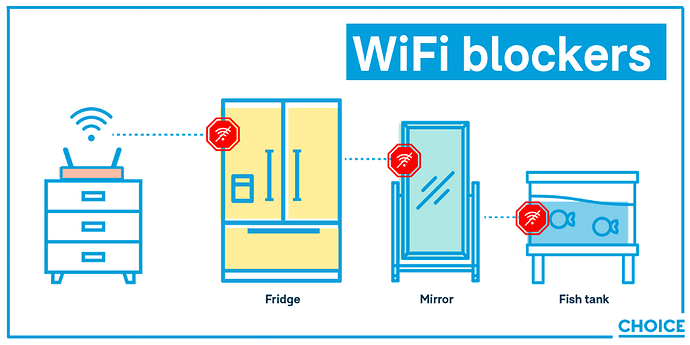There are numerous common tips on how to get the best from your home wifi set up. Most seem to be logical and useful.
Our most common concerns are often loss of signal passing through walls and large objects, or interference from other sources. EG microwaves, wireless head phones, neighbours wifi network etc.
One simple thing I have done when there appears to be a wifi signal issue is to copy a large file from a computer connected to the home wifi router to the laptop or PC where I am working. I can observe the data transfer rate in Windows explorer or through the performance monitor.
By repeating this in a variety of locations and comparing results I have been able to determine or eliminate if there is a particular object that makes any difference. EG iron framed upright piano!
It is interesting to also do a trial setup at a similar distance to where you may want to work, and to be sure there is a clear line of sight to the wifi router. This will give you a base test of just how good or poor the wifi router and device you are working on really are.
Experience suggests that there is often a significant difference in performance between individual wifi devices. Standing a wifi router up or laying it down changes the internal aerial orientation. One position may work better than another. Trial and test, adjust and retest.
This approach requires little technical knowledge. It also concedes that you are limited to making the most of what you have.
We’ve noted also significant differences between individual laptops. We suspect that the quality of a laptops wifi and our wifi routers may have more of an impact on getting good home wifi than any other consideration. You may be able to move the piano or the wifi router to a higher shelf. Upgrading the wifi in a laptop is not so easy!
Using the 5GHz band for a home wifi network is definitely faster, however the range is more limited than the 2.4GHz bands.
To get around problems, I’ve previously resorted to long runs of Ethernet cable, wifi network extenders, dedicated wireless APs running as stand alone bridges and power line Ethernet adaptors. All have their own uses, however nothing beats an Ethernet wired solution for speed and reliability.
PS. I have also used inSSIDer for many years.
 Unfortunately the program is no longer available as a free download but Googling “metageeks inssider home” may prove of interest to some.
Unfortunately the program is no longer available as a free download but Googling “metageeks inssider home” may prove of interest to some.



